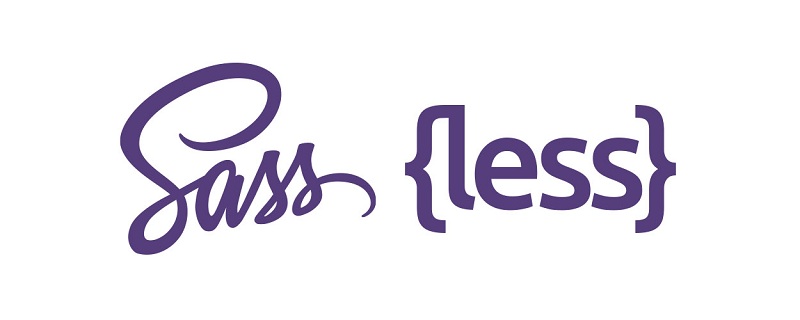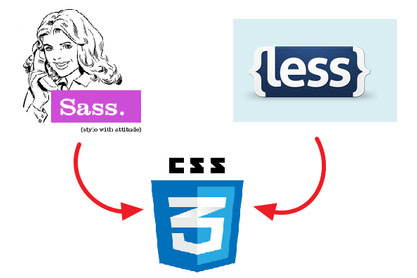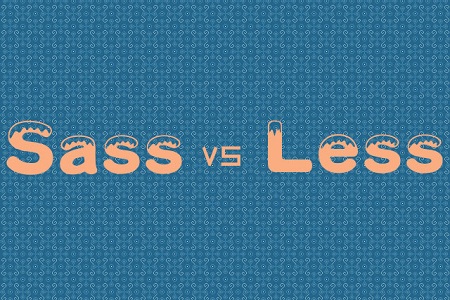What is the difference between Sass and Less
The difference between Sass and Less is: 1. Less runs on JS, and Sass is used on Ruby; 2. The way they write variables is different; 3. Only looping values are allowed in Less, while Any type of data can be traversed in Sass; 4. Sass has Compass, and Less has Preboot.

#The operating environment of this tutorial: Windows 7 system, Dell G3 computer.
Sass and Less are both CSS preprocessors, so what are the differences between them? This article will introduce to you the difference between Sass and Less, I hope it will be helpful to you.
First let’s take a lookWhat is a CSS preprocessor?
The CSS preprocessor is a scripting language that uses a specialized programming language to design Web page styles, and then converts them into normal CSS styles to build dynamic CSS. style.
The CSS preprocessor adds some programming features to CSS without having to consider browser compatibility issues.
Sass and Less are two common CSS preprocessors. We can convert the styles edited by Sass and Less into normal css styles.

The learning of CSS preprocessors is similar. Once we learn a CSS preprocessor, if necessary, switch to another CSS preprocessor. It's not difficult.
Let’s take a look atWhat is the difference between Sass and Less

1. Less runs on JS and Sass is used on Ruby.
Sass is based on Ruby and requires Ruby to be installed. Less and Sass are built similarly in Ruby, but it has been ported to JavaScript. In order to use LESS, we can upload the applicable JavaScript files to the server or compile the CSS table via an offline compiler.
2. The way to write variables is different.
Sass uses $, while Less uses @.
3. In Less, only circular values are allowed.
In Sass, we can iterate over any type of data. But in Less, we can only use recursive functions to loop over values.
4. Sass has Compass, and Less has Preboot
Sass and LESS have extensions that can be used to integrate mixins (the ability to store and share CSS declarations throughout the site) .
Sass has Compass for mixins, which includes all available options as well as future supported updates.
LESS has Preboot.less, LESS Mixins, LESS Elements, gs and Frameless. Software support for LESS is more fragmented than Sass, resulting in many different extension options that may not all work the same way. For projects, we may need all listed extensions to get similar performance to Compass.
Summary: The above is the entire content of this article, I hope it will be helpful to everyone's study.
The above is the detailed content of What is the difference between Sass and Less. For more information, please follow other related articles on the PHP Chinese website!

Hot AI Tools

Undresser.AI Undress
AI-powered app for creating realistic nude photos

AI Clothes Remover
Online AI tool for removing clothes from photos.

Undress AI Tool
Undress images for free

Clothoff.io
AI clothes remover

AI Hentai Generator
Generate AI Hentai for free.

Hot Article

Hot Tools

Notepad++7.3.1
Easy-to-use and free code editor

SublimeText3 Chinese version
Chinese version, very easy to use

Zend Studio 13.0.1
Powerful PHP integrated development environment

Dreamweaver CS6
Visual web development tools

SublimeText3 Mac version
God-level code editing software (SublimeText3)

Hot Topics
 1378
1378
 52
52
 Working With GraphQL Caching
Mar 19, 2025 am 09:36 AM
Working With GraphQL Caching
Mar 19, 2025 am 09:36 AM
If you’ve recently started working with GraphQL, or reviewed its pros and cons, you’ve no doubt heard things like “GraphQL doesn’t support caching” or
 Show, Don't Tell
Mar 16, 2025 am 11:49 AM
Show, Don't Tell
Mar 16, 2025 am 11:49 AM
How much time do you spend designing the content presentation for your websites? When you write a new blog post or create a new page, are you thinking about
 Building an Ethereum app using Redwood.js and Fauna
Mar 28, 2025 am 09:18 AM
Building an Ethereum app using Redwood.js and Fauna
Mar 28, 2025 am 09:18 AM
With the recent climb of Bitcoin’s price over 20k $USD, and to it recently breaking 30k, I thought it’s worth taking a deep dive back into creating Ethereum
 Creating Your Own Bragdoc With Eleventy
Mar 18, 2025 am 11:23 AM
Creating Your Own Bragdoc With Eleventy
Mar 18, 2025 am 11:23 AM
No matter what stage you’re at as a developer, the tasks we complete—whether big or small—make a huge impact in our personal and professional growth.
 Vue 3
Apr 02, 2025 pm 06:32 PM
Vue 3
Apr 02, 2025 pm 06:32 PM
It's out! Congrats to the Vue team for getting it done, I know it was a massive effort and a long time coming. All new docs, as well.
 A bit on ci/cd
Apr 02, 2025 pm 06:21 PM
A bit on ci/cd
Apr 02, 2025 pm 06:21 PM
I'd say "website" fits better than "mobile app" but I like this framing from Max Lynch:
 Let's use (X, X, X, X) for talking about specificity
Mar 24, 2025 am 10:37 AM
Let's use (X, X, X, X) for talking about specificity
Mar 24, 2025 am 10:37 AM
I was just chatting with Eric Meyer the other day and I remembered an Eric Meyer story from my formative years. I wrote a blog post about CSS specificity, and
 Can you get valid CSS property values from the browser?
Apr 02, 2025 pm 06:17 PM
Can you get valid CSS property values from the browser?
Apr 02, 2025 pm 06:17 PM
I had someone write in with this very legit question. Lea just blogged about how you can get valid CSS properties themselves from the browser. That's like this.




